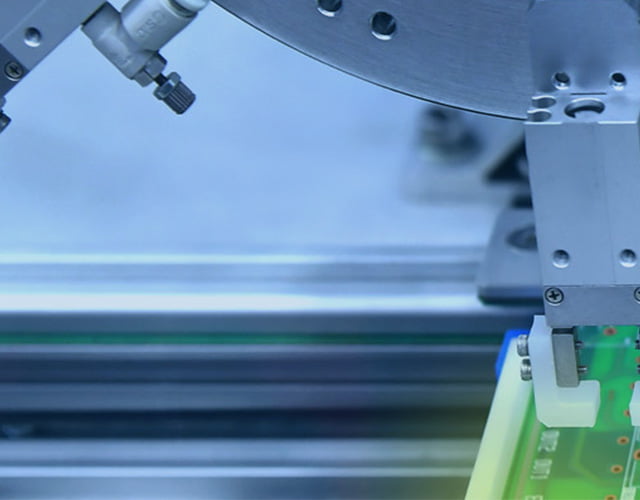Know ABF Substrate and IC Carrier Board in 5 Minutes
ABF Substrate & IC Board
To understand the ABF substrate, you must first know its relationship with the IC board.
IC board or IC Carrier, developed on the basis of HDI circuit board, is a technological innovation adapted to the rapid development of electronic packaging technology, with high density, high precision, high performance, miniaturization, and excellent features, IC boards are mainly used to establish signal connections between ICs and PCBs, they can also protect circuits, fix circuits and dissipate waste heat.

Types of IC Boards

According to the packaging method, IC boards can be divided into BGA packaging substrates, CSP packaging substrates, FC packaging substrates, and MCM packaging substrates.
1. BGA package substrate
Advantages: significantly increase chip pins, and perform well in chip heat dissipation and electrical performance.
Application: suitable for IC packages with more than 300 pins.
2. CSP package substrate
Advantages: single chip package, lightweight and small size.
Application: used in memory products, telecommunication products, and electronic products with a small number of pins.
3. FC package substrate
Advantages: by flipping the package of the chip, it has low signal interference, low circuit loss, good performance, and effective heat dissipation.
Application: widely used in CPU, GPU, Chipset, and other products.
4. MCM package substrate
Advantage: Absorb chips with different functions into one package. It has the characteristics of lightness, thinness, shortness, and miniaturization, but since multiple chips are packaged in one package, this type of substrate does not perform well in terms of signal interference, heat dissipation, fine pitch, etc.
Application fields: used in military and aerospace fields.
According to different packaging materials, IC boards can be divided into hard packaging substrates, flexible packaging substrates, and ceramic packaging substrates.
1. Hard substrates
Main materials and application areas: BT resin (MEMS, communication and memory chips, LED chips), ABF substrate (applied to a large number of high-end chips such as CPU, GPU, and chipset), MIS (applied to analog, power IC, and digital currency, etc. market area).
2. Flexible substrate
Main materials and application areas: PI, PE (applied to automotive electronics, consumer electronics can also be used in military fields such as launch vehicles, cruise missiles, and space satellites).
3. Ceramic substrate
Main materials and application fields: alumina, aluminum nitride, silicon carbide (used in semiconductor lighting, laser, and optical communication, aerospace, automotive electronics, deep sea drilling, and other fields).
According to the application, IC boards can be divided into memory chip packaging substrates, micro-electromechanical system packaging substrates, radio frequency module packaging substrates, processor chip packaging substrates, and high-speed communication packaging substrates.
1. Memory chip packaging substrate (eMMC), mainly used for storage modules of smartphones and tablet computers, solid state drives, etc.
2. Micro-Electro-Mechanical System Packaging Substrate (MEMS), which is mainly used for sensors in smartphones, tablet computers, and wearable electronic products.
3. RF module packaging substrate (RF), mainly used for RF modules of mobile communication products such as smartphones.
4. Processor chip WB-CSP, mainly used for baseband and application processors of smartphones and tablet computers.
5. The processor chip FC-CSP, is mainly used for baseband and application processors of smartphones and tablet computers.
6. High-speed communication packaging substrates, are mainly used for conversion modules in data broadband, telecommunications, FTTX, data centers, security monitoring, and smart grids.
ABF Substrate & BT Resin
The vast majority of IC boards are packaged with resin, among which ABF substrate and BT resin are the most widely used.
BT Resin

BT resin is used to produce BT IC carrier boards. Because BT resin has many excellent properties such as heat resistance, moisture resistance, low dielectric constant, and low dissipation factor, it is often used to stabilize dimensions, prevent thermal expansion and contraction, and improve equipment yield.
Since the BT substrate has a glass fiber yarn layer, which is harder than the FC substrate of ABF substrate, it is more difficult to wire and drill holes, and cannot meet the requirements of thin lines. It is mainly used in memory chips, MEMS chips, RF chips, and LED chips. Application terminals are mainly various mobile devices such as smartphones.
ABF Substrate

ABF substrates are mainly used for the production of ABF IC carriers, which are developed by Intel and are currently monopolized by Japan Ajinomoto, and are used to produce high-end substrates such as FC.
Compared with BT resin, ABF substrate can be used as an IC with thinner lines and is suitable for a high-pin count and high transmission, but the material is easily affected by thermal expansion and contraction and has low reliability. It is mainly used for high-performance CPU, GPU, FPGA, ASIC, etc. Computing (HPC) chip FC package.
Status and Outlook of ABF Substrate
In the M1 Ultra chip launched by Apple, the InFO-L packaging technology used uses a large-area ABF, which requires twice the area of the M1 Max, and requires higher precision.
It is predicted that among PC CPUs, the PC CPU/GPU ABF consumption area will be about 11.0% and 8.9% CAGR from 2022 to 2025, respectively, and the CPU/GPU 2.5D/3D packaging ABF consumption area will be as high as 36.3% and 99.7% CAGR respectively. For server CPUs, it is predicted that the CPU/GPU ABF consumption area will be about 10.8% and 16.6% CAGR from 2022 to 2025, and the CPU/GPU 2.5D/3D package ABF consumption area will be about 48.5% and 58.6% CAGR.
All signs mean that the advancement of large computing power chips to advanced packaging will become the main reason for the growth in demand for ABF substrates.
In addition, another driving factor for ABF is the rise of new technologies and applications such as AI, 5G, autonomous driving, and the Internet of Things. Taking the previously most popular metaverse as an example, head-mounted display devices such as AR/VR are important entrances to the future metaverse, and there are huge chip opportunities hidden behind them, and these chip opportunities will also become a new growth force to promote the growth of the ABF substrate market.
Get BT and ABF Substrates
PCBANow is a 15 years contract electronics manufacturer, also one of the long-term partners of top material suppliers. We currently have a wealth of ABF materials and BT resin stocks, which can provide you with high standards and consistency from raw materials to PCBA solutions support, welcome to contact us to get a quote.






